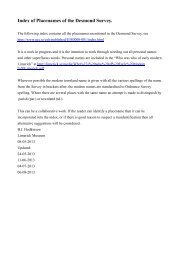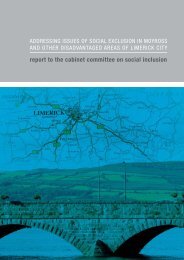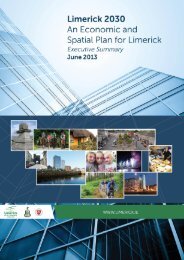An Economic and Spatial Plan for Limerick Appendices
An Economic and Spatial Plan for Limerick Appendices
An Economic and Spatial Plan for Limerick Appendices
You also want an ePaper? Increase the reach of your titles
YUMPU automatically turns print PDFs into web optimized ePapers that Google loves.
<strong>Limerick</strong> 2030 <strong>An</strong> <strong>Economic</strong> <strong>and</strong> <strong>Spatial</strong> <strong>Plan</strong> <strong>for</strong> <strong>Limerick</strong><br />
Residential<br />
The Irish Housing Market is characterised by a strong owner-occupied sector with a predisposition<br />
towards family homes (semi-detached <strong>and</strong> detached). This led to a strong <strong>and</strong> exponentially<br />
increasing dem<strong>and</strong> <strong>for</strong> such properties throughout the “boom years”. Prices in all areas rose rapidly<br />
<strong>and</strong> as apartment type developments came on stream, these were purchased by individuals hoping<br />
to get on the property ladder. Since 2007 prices <strong>for</strong> all types of housing have fallen, with apartment<br />
developments being hit hardest. In general, residential prices have fallen some 54% <strong>and</strong> continue to<br />
fall, with the National Property Index down 15.27% year on year in May 2012. The average quarterly<br />
fall in prices is in the region of 4.3%.<br />
Figure 4: House Price Index<br />
Source: ESRI, 2012<br />
According to the latest report by daft.ie, price disparities between small <strong>and</strong> large properties have<br />
increased, as there is a latent dem<strong>and</strong> <strong>for</strong> larger family type homes. This is supported by research<br />
from the <strong>Economic</strong> & Social Research Institute (ESRI), which states in its latest Quarterly <strong>Economic</strong><br />
Commentary that in key urban areas, the stock of vacant houses is not very large. This is particularly<br />
the case <strong>for</strong> houses in the greater Dublin area. A significant increase in dem<strong>and</strong> to buy houses in<br />
these urban locations could exhaust the vacant stock <strong>and</strong>, given a very low level of house-building,<br />
this would begin to put upward pressure on prices. 23<br />
The Census of 2011 showed a continued increase in population, which may point to a latent<br />
dem<strong>and</strong> <strong>for</strong> housing, particularly larger family homes in good locations. Af<strong>for</strong>dability is no longer a<br />
problem in absolute terms, but lending is still seen as a barrier to entry into the owner-occupied<br />
23 ESRI Quarterly <strong>Economic</strong> Commentary, Summer 2012<br />
June 2013 58

















